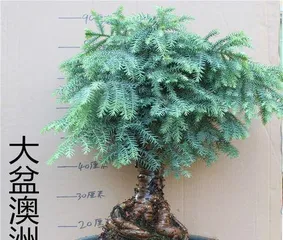Taiwan fir is a precious variety in bonsai, with extremely high ornamental value. Therefore, more and more people like to plant it at home to create a beautiful bonsai. However, its maintenance methods and precautions are also very complex. How can it grow healthily and become a beautiful Taiwan fir bonsai? Next, we will introduce it in detail.

I. Choosing the Right Potting Soil
To ensure the healthy growth of a Taiwan fir bonsai, the first step is to choose the right potting soil. Generally, it is best to use sandy soil or leaf mold as the base, and then add an appropriate amount of soil and lime powder. This can improve the drainage and aeration of the potting soil, which is beneficial for root growth.
II. Controlling Watering Amount
Watering is one of the important factors for ensuring the growth of a Taiwan fir bonsai. However, watering is also the most problematic part of the maintenance process. Pay attention to controlling the amount of water, do not let the potting soil be too wet or too dry. Generally, watering once a week is sufficient.

III. Maintaining Ventilation
Taiwan fir bonsai has relatively high requirements for ventilation, so it is important to maintain ventilation during the maintenance process. You can place the bonsai in a well-ventilated place, or regularly open doors and windows to allow air circulation.
IV. Proper Fertilization
Fertilization is also an important part of ensuring the growth of a Taiwan fir bonsai. However, over-fertilization should be avoided as it can damage the roots. Generally, fertilizing once a month is sufficient. You can choose organic fertilizer or compound fertilizer and adjust according to different seasons.
V. Avoiding Sun and Rain
Taiwan fir bonsai cannot be exposed to direct sunlight, nor can it be soaked in rainwater. When placing the Taiwan fir bonsai, choose a location that is protected from sun and rain. At the same time, during heavy rain, it needs to be moved indoors in time to avoid getting wet.

VI. Preventing Pest Infestation
Pests are one of the important factors affecting the growth of a Taiwan fir bonsai. You can prevent and control them by spraying insecticides and removing pests and diseases. At the same time, it is also necessary to check regularly to detect pest infestations in a timely manner.
VII. Regular Pruning
Regular pruning can ensure the beautiful shape of the Taiwan fir bonsai. However, it is important to choose the right time for pruning. It is best to prune in spring and autumn, and avoid pruning in summer and winter to avoid affecting the growth of the tree.
VIII. Paying Attention to Warmth
Taiwan fir bonsai has relatively high requirements for temperature and cannot be exposed to a cold environment. When winter comes, it is necessary to strengthen warmth-keeping measures, such as using thermal blankets or insulation boards to protect the bonsai.
IX. Paying Attention to Timely Transplanting
Timely transplanting can promote the growth of a Taiwan fir bonsai. However, it is important to choose the right time for transplanting to avoid affecting the growth of the bonsai. It is best to transplant in spring or autumn.
X. Avoiding Man-made Damage
Man-made damage is also one of the important factors affecting the growth of a Taiwan fir bonsai. When moving or pruning the bonsai, be careful to handle it gently to avoid causing damage to the tree.
XI. Maintaining Air Humidity
Taiwan fir bonsai has relatively high requirements for air humidity. In a dry environment, you can maintain air humidity by spraying water, placing a hygrometer, etc.
XII. Paying Attention to the Prevention of Pests and Diseases
Preventing pests and diseases is an important part of ensuring the healthy growth of a Taiwan fir bonsai. You can prevent them by strengthening maintenance and regularly removing fallen leaves.
XIII. Paying Attention to Root Growth
Root growth is one of the important factors for ensuring the healthy growth of a Taiwan fir bonsai. During transplanting or maintenance, pay attention to protecting the roots and avoid causing damage to them.
XIV. Paying Attention to Suitable Temperature
Suitable temperature is also an important factor for ensuring the healthy growth of a Taiwan fir bonsai. Generally, the most suitable temperature is 18-22°C. When summer or winter comes, it is necessary to adjust the temperature to avoid causing damage to the bonsai.
XV. Regular Inspection
Regular inspection can help detect and solve problems in a timely manner, ensuring the healthy growth of a Taiwan fir bonsai. During the maintenance process, pay attention to regularly check the condition of the bonsai and find and solve problems in a timely manner.
The maintenance methods and precautions for a Taiwan fir bonsai are very complex and require us to care for it patiently and meticulously. Only through continuous exploration and practice can we create a healthy and beautiful Taiwan fir bonsai.